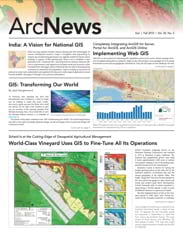When I visited India in April 2010, I had the honor of meeting with Prime Minister Dr. Manmohan Singh and many other Indian leaders. It was during that visit that I learned of India’s vision for a comprehensive National GIS. I had many interesting conversations with various experts where we discussed some of the challenges for such a national endeavor, not the least of which was that a project of such massive scale could only be successful if it involved all levels of government, private enterprise, and the citizens of India themselves—thereby making it a truly national enterprise.
I returned to India in September 2011 and was thrilled to see the progress India had made toward realizing its vision of National GIS. In the National GIS workshop that I attended, I interacted with some of the key visionaries of the National GIS—Mr. Montek Singh Ahluwalia, deputy chairman of the Planning Commission; Mr. Sam Pitroda, adviser to the prime minister on information technology; Dr. K. Kasturirangan, member (science) of the Planning Commission; Dr. Shailesh Nayak, chairman of the National GIS Interim Core Group and secretary, Ministry of Earth Sciences; Dr. T. Ramasami, secretary of the Department of Science and Technology; and Dr. Mukund Rao, secretary of the National GIS Interim Core Group and chairman of the GIS Task Force of the Karnataka Knowledge Commission—who, I must say, over past years has played a prominent and leadership role for this Indian endeavor. Apart from these key personalities, the Interim Core Group had 10 other national experts—together it was their experience and visionary perspectives that have shaped the National GIS vision. In that workshop, there were 200 experts—from government, industry, and academia—who spent a whole day debating, sharing, and fine-tuning the already crafted (and well discussed) National GIS vision. In all these interactions, what struck me was that a national movement had been set in action that was shaping a new dimension of nationally and socially relevant GIS.
This July at the 2013 Esri International User Conference (Esri UC), the vision of National GIS was unfolded by Pitroda in a Keynote Address that struck the plenary audience of thousands with awe about how India was slowly transforming its strengths (and complexities) into a great innovation advantage to set about a new information regime that empowers citizens, brings good governance, and encourages sustainable development—thereby bringing benefits of GIS to citizens, government, and enterprises. As Pitroda said at the Esri UC, ” . . . addressing the bottom of the pyramid” was essential, and a National GIS is expected to do that. He also pointed out that the program has now been approved and sanctioned by the Indian government and that the program will take off this year and even establish a separate Indian National GIS Organization that will be dedicated and committed to further the use of GIS. It is truly visionary of the Indian government to undertake such a broad-based social infrastructure project that promises to bring tremendous dividends and benefits to the citizens of the world’s largest democracy.
Even as India has made this great stride toward visualizing National GIS, a big challenge that it faces is the need for technically strong and visionary leadership for implementing National GIS successfully. I am very impressed and thrilled by what India has been able to accomplish in such a short amount of time. The following article shares some of the unique and important characteristics of India’s National GIS vision. I believe that India is on the right track and that it can serve as a role model for other nations looking at the idea of National GIS as a platform for bringing together governments, businesses, and people. The world can learn a lot from India.


